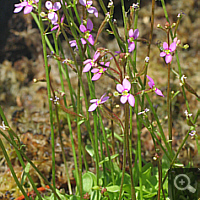Triggerplant (Stylidium)
Overview
The genus of Triggerplants is with circa 300 species the largest carnivorous genus. Except for 4 species all are native exclusive in Australia. Mostly they are rosette-building, less frequent erect-climbing or shrub-like plants. The largely number of Triggerplants is perennial. The habitats range from a brook bank, where they partly grow also semi-aquatic, to parly dry sandy soils. The name derives from the pollination mechanism. Triggerplants are touch-sensitive. Just as a insect is landing on the flower it triggers a stimulus, as a result, that the gynostemium (a column compost of the stamens and the stigma) is abruptly pressed on the insect. In the case of younger flowers the insect is powdered with pollen, in the case of older flowers the stigma shows a further growth and has in the meantime repressed the stamens sidewards. In this case the stigma is pressed on the insect and receives potentially existing pollen. By this mechanism a self-fertilisation is inhibited by the plants.
Trap mechanism
The basically trap mechanism was already detailed described on the previous site. Partially the plants presents glandular hairs, with which insects are caught. A few years ago the production of proteases (enzymes, which split proteins) was proven. Therefore Triggerplants are real carnivorous plants.
Culture and propagation
Until now I have not cultivated this genus, so that I can not publish own experiences on this site. Some species should indeed be easy to cultivate and be suitable for a cultivation on the windowsill. In addition species probably exist, which are only suitable for experts.

